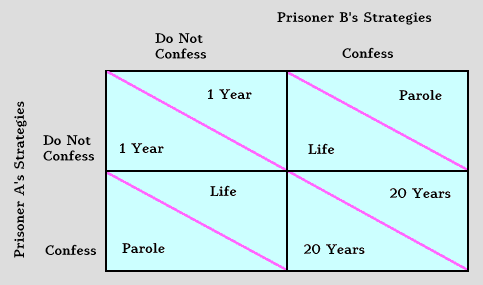Ironically, it is in Saw V, long after most viewers stopped paying attention, that things began to get really interesting. The central game in Saw V accords more closely to the classic Prisoner's Dilemma (see Fig. 1 below) than any in the series: five players are told they must cooperate to survive, but quickly turn on each other in a frenzied struggle to survive. By the time only two are left--having escaped physical trauma at the expense of the others--they realize that cooperating would've meant only a manageable amount of bodily harm for each player. But since everyone else died in a frenzy of all-or-nothing competition, the final test (which requires a minimum amount of blood from each player) has to be shared among two, and is likely to prove fatal to both.

Not shown on chart: severed limbs.
And when was this bloody parable released? October 2008, the month of the bailout, when Lehman Brothers CEO Richard Fuld (the real-life equivalent of the film's asshole journalist disintegrated by a nailbomb) appeared before Congress and stated that his decisions were "prudent and appropriate" given the information available at the time.
What also makes Saw V interesting is the identity of the players: each was a participant in a callous real estate scam that left several innocent bystanders dead, from the developer who set the plot in motion to the arsonist who burned down the building (who are actually the film's Final Girls, although one is a dude). Jigsaw's earlier games always had a fundamentally conservative cast, focusing on placing junkies and derelicts into life-threatening situations in order to motivate them to pull themselves up by their bootstraps. By pitting them against each other in a life-and-death struggle for diminishing returns, the movies provide a brutal dramatization of the cauldron that forged modern horror movies: Reaganism.

Hello, taxpayer. I want to play a game.
This is how the Saw series represents a long, savage reenactment of how free market capitalism conquered the world: rewarding players who would do whatever was necessary to survive, and brutally punishing those who hesitate when asked to take drastic action that may fatally imperil others. The poor, sick, and weak are asked to make drastic sacrifices or die. The trickle-down logic of Jigsaw's traps is explained by the fourth movie, which is also the nadir of the series. In this outing, Jigsaw's wife, a well-meaning liberal, opens an urban free clinic only to be rewarded by a junkie-induced miscarriage; the film thus combines the failure of rehabilitation, socialized medicine, and the death of the unborn into one incredible sledgehammer blow! But just a movie later, the brutal logic of Jigsaw's vengeance turns on those who had previously escaped its wrath. (It is also conceivable that Jigsaw saw people like the unscrupulous developer as competition, since his plans required a ready supply of crumbling, abandoned buildings.)
Saw VI takes the progressive turn of the fifth film and runs with it, providing what may be the best entry in the series aside from the original film. In a crowd-pleasing flourish, the victims of the sixth film's gamesmanship are greedy insurance agents--who, it is revealed, refused to pay for Jigsaw's experimental treatment in the first place! The sixth movie also features another heavily modified prisoner's dilemma, altered to better reflect real world circumstances: here the negative outcome (to wit, being forcibly injected with industrial-strength horror movie acid) is not meted out to the players, but onto the claims adjuster himself, providing a grisly revenge fantasy for those victimized by a financial industry that eliminated risk by socializing it.
It's easy for mainstream commentators to dismiss horror movies, especially those with sequels approaching/surpassing double digits, but they've always carried a societal critique that's often nowhere to be found at the Oscars. And torture porn, so widely-reviled as a filmic mode, has a lot more meat on its bones (pun intended) than it's given credit for. George Romero himself has argued that they're "lacking metaphor"--are you kidding me? Saw is all metaphor.
No comments:
Post a Comment